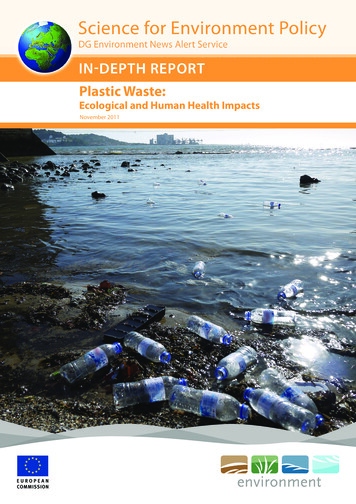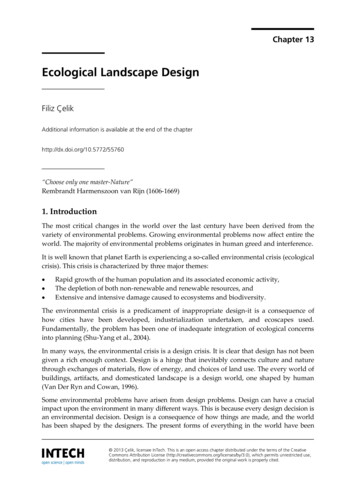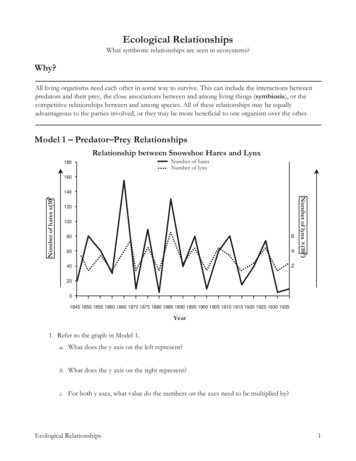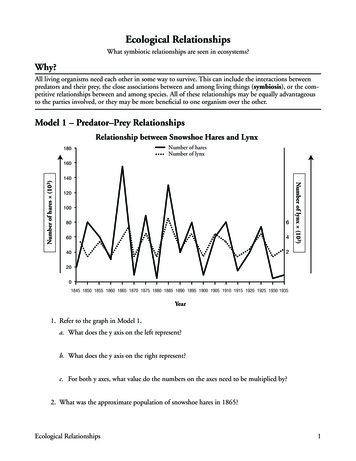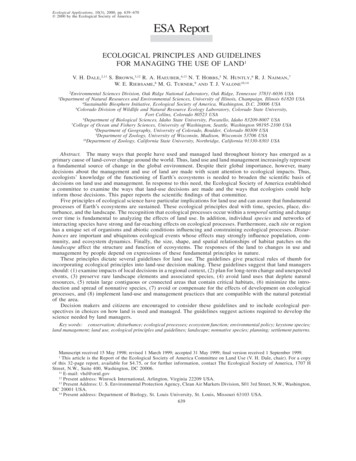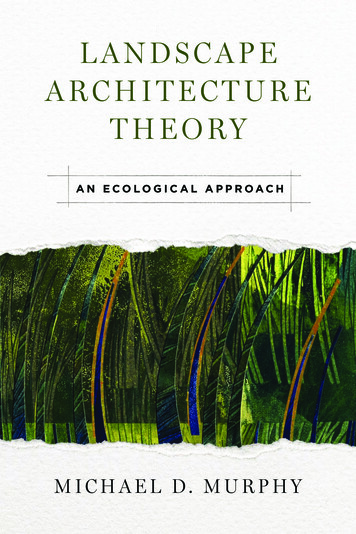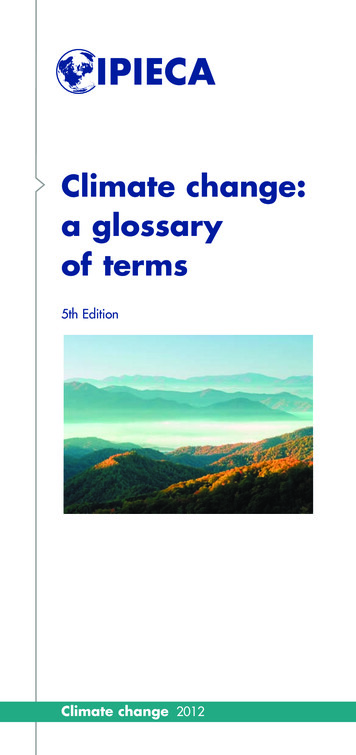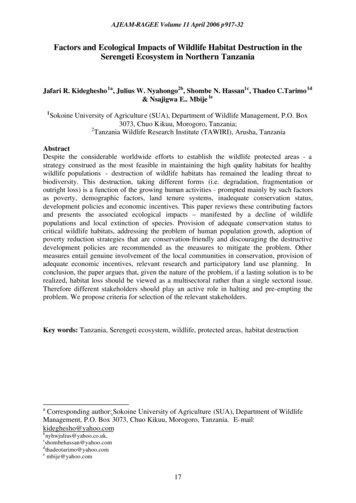
Transcription
AJEAM-RAGEE Volume 11 April 2006 p917-32Factors and Ecological Impacts of Wildlife Habitat Destruction in theSerengeti Ecosystem in Northern TanzaniaJafari R. Kideghesho 1a , Julius W. Nyahongo2b, Shombe N. Hassan1c, Thadeo C.Tarimo 1d& Nsajigwa E. Mbije 1e1Sokoine University of Agricultur e (SUA), Department of Wildlife Management, P.O. Box3073, Chuo Kikuu, Morogoro, Tanzania;2Tanzania Wildlife Research Institute (TAWIRI), Arusha, TanzaniaAbstractDespite the considerable worldwide efforts to establish the wildlife protected areas - astrategy construed as the most feasible in maintaining the high quality habitats for healthywildlife populations - destruction of wildlife habitats has remained the leading threat tobiodiversity. This destruction, taking different forms (i.e. degradation, fragmentation oroutright loss) is a function of the growing human activities - prompted mainly by such factorsas poverty, demographic factors, land tenure systems, inadequate conservation status,development policies and economic incentives. This paper reviews these contributing factorsand presents the associated ecological impacts – manifested by a decline of wildlifepopulations and local extinction of species. Provision of adequate conservation status tocritical wildlife habitats, addressing the problem of human population growth, adoption ofpoverty reduction strategies that are conservation- friendly and discouraging the destructivedevelopment policies are recommended as the measures to mitigate the problem. Othermeasures entail genuine involvement of the local communities in conservation, provision ofadequate economic incentives, relevant research and participatory land use planning. Inconclusion, the paper argues that, given the nature of the problem, if a lasting solution is to berealized, habitat loss should be viewed as a multisectoral rather than a single sectoral issue.Therefore different stakeholders should play an active role in halting and pre-empting theproblem. We propose criteria for selection of the relevant stakeholders.Key words: Tanzania, Serengeti ecosystem, wildlife, protected areas, habitat destructionaCorresponding author: Sokoine University of Agriculture (SUA), Department of WildlifeManagement, P.O. Box 3073, Chuo Kikuu, Morogoro, Tanzania. E- @yahoo.comc17
AJEAM-RAGEE Volume 11 April 2006 p917-321. IntroductionWildlife is a land resource of cultural, ecological and economic significance. It is a renewableresource whose survival depends, among other factors, on the quality of habitats. Theimportance of habitats is derived from their ecological roles in provision of shelter, breedingplaces, dispersal and foraging grounds for a variety of wildlife species. They also allow freemovement for animals to other geographical localities where access to critical resources for(wildlife) survival and exchange of the genetic material occur. Wildlife habitats are,therefore, critical components for ecological integrity and the long-term survival of theecosystem.Destruction or loss of wildlife habitats reduces their potential utility. Hunter (2002:193)defines three forms of habitat destruction (viz. degradation, fragmentation and outright loss).While habitat degradation is “the process by which habitat quality for a given species isdiminished”, fragmentation “is the process by which a natural landscape is broken up intosmall parcels of natural ecosystems, isolated from one another in a matrix of lands dominatedby human activities”. Outright loss of habitats occurs when habitat quality is so low such thatthe environment is no longer usable by a given species.Although previously habitat changes were relatively a minor factor in decline of species,being overshadowed for centuries by overexploitation and introduction of exotic species(Soule et al. 1979; WCMC 1992), their relative importance has increased in recent decades.Habitat loss has emerged the most severe threat to biodiversity worldwide (Brooks et al.2002b; IUCN 2004; Naeem et al. 1999; Smith and Smith 2003) threatening some 85% of allspecies classified as "threatened" and "endangered” in the IUCN's Red Lists (IUCN 2004). Itis the most pervasive to birds, mammals and amphibians. It affects 86% of all threatenedbirds, 86% of threatened mammals and 88% of threatened amphibians(www.iucn.org/themes/ssc). The effect of other threats is relatively lower. For instance,overexploitation affects only 30% of threatened birds, 33% mammals and 6% amphibianswhile introduction of alien species affects 30% and 11% of threatened birds and amphibians,respectively (ibid).Human activities such as overgrazing, deforestation, bush fires, mining, urbanizationand cultivation are the principle causes of habitat destruction (See e.g. Kauzeni 1995;Kideghesho 2005; Mwalyosi 1992). These activities are expanding in line with humanpopulation growth and poverty increase. Maintaining the high quality habitats and ensuringthe long-term ecological integrity is therefore increasingly becoming an importantmanagement challenge. Establishment of wildlife PAs has been adopted as the most feasiblestrategy to this end. Currently some 104,791 PAs covering a total area of about 20 millionkm2 or 12.7% of the earth’s surface (Chape et al. 2005) have been created. This is a dramaticincrease compared to only 8,500 PAs covering some 7.7 km2 (equivalent to 5.2% of theearth’s sur face) existed in the last decade (IUCN/CNPAA 1990; Pretty and Pimbert 1995).The PAs, have, however, been criticised for inadequacy as self-sustaining entities inguaranteeing the long-term survival of flora and fauna. Bennet (1997) outlines four reasonsfor this inadequacy: (1) PAs do not represent all natural communities; (2) most PAs are toosmall to maintain viable populations of all species and to maintain natural ecologicalprocesses; (3) movement patterns of many animals regularly cross PAs boundaries; and (4)PAs are not protected from surrounding land use categories and may, therefore, be degradedby processes arising in the surrounding landscapes.The above reasons augment the importance of ecological linkage and the ecological unitof sufficient size to encompass as wide a contiguous range of ecological communities aspossible. Ecological isolation has numerous ecological consequences. For example, it limitsflow of genes between wildlife populations in different geographical localities and, therefore,may lead to genetic erosion. It may also limit natural dispersal of organisms and thus18
AJEAM-RAGEE Volume 11 April 2006 p917-32exacerbating the risk of extinction in case of natural catastrophes such as epidemics, drought,fire, earthquakes or floods. In addition, ecological isolation may be detrimental to speciesthat require large ranges and those with complex requirements at different stages in their lifecycles or at different seasons.Some scientific studies have led to predictions and generalizations on the ecologicalimpacts of isolation and small ecological units. Predictions of Soule et al (1979) for loss oflarge mammals in East Africa suggest that when the areas are isolated for 50, 500 and 5,000years without intervention of scientific management, the smallest reserves may lose 23%,65% and 88% of the species. In contrast the risk is lower for largest reserves. They may lose6%, 35% and 73% in the respective time intervals. Likewise, extrapolations from estimatesfor habitat loss have led to the most widely quoted generalizations that, loss of 90% of habitatresults in loss of half of the species present (WCMC 1992: Meffe and Carroll 1997).In Africa loss of wildlife habitats is a widespread phenomenon. The current loss isestimated at 60% (Newmark & Hough 2000). Human population pressure is cited as the maincontributor to this loss, mainly through deforestation prompted by increased demand forarable land, settlements and fuelwood. The majority of sub-Saharan Africa's population isdependent on fuelwood: 82% of all Nigerians, 70% - Kenyans, 80% - Malagasies, 74% Ghanaians, 93 - Ethiopians, 90% - Somalians and 81% - Sudanese (Hinrichson 1994).Tanzania, one of the African countries, is by no means exceptional to this scenario.According to the World Resources Institute report on status of the world habitats in the late1980s, the country had 43% of its original habitats (ca. 886 200 km2 ) lost (WRI 1989). Localextinction of fauna species and increased number of species that are prone to extinction indifferent localities manifest the impact of this loss (e.g. Miller and Harris 1977; Newmark1996; Hassan 1998; Gamassa 1998; Brooks et al 2002; Kideghesho 2001).Understanding the contributing factors and ecological impacts inflicted by habitat destructionon biodiversity is essential in devising the effective mitigative measures. In this paper we usethe literature and our personal experience on Serengeti ecosystem to review the process ofhabitat destruction by attempting to address the following questions: (1) What are the factorscontributing to habitat destruction (2) What are the ecological impacts and how could theseimpacts be mitigated? Before embarking to these questions we provide brief description ofSerengetiSerengeti EcosystemSerengeti ecosystem is located in the northern Tanzania and extends to south-western Kenyabetween latitudes 10 and 30 S and longitudes 340 and 360 E. It spans some 30,000 km2 andforms one of the important cross-border conservation regions in the world. The ecosystem – ahome to about 70 larger mammal and some 500 avifauna species – supports one of thelargest herds of migrating ungulates and the highest concentrations of large predators in theworld (Sinclair 1979; Sinc lair and Arcese 1995a). Its high diversity in terms of species is afunction of diverse habitats ranging from riverine forests, swamps, kopjes, grasslands andwoodlands.Over 80% of Serengeti ecosystem is legally protected through a network of protectedareas (PAs) (Figure 1), although the management regimes to some are too weak to guaranteetheir effective protection. These PAs include Tanzania’s Serengeti National Park - SNP(14,763 km2 ), Ngorongoro Conservation Area - NCA (8,288 km2 ), and Kenya’s Maasai MaraNational Reserve - MMNR (1,368 km2 ). NCA and SNP together were designated as oneBiosphere Reserve in 1981 and were inscribed separately on the World Heritage List in 1979and 1981 respectively (UNESCO 2003). Also included in the PAs network are four GameReserves (GRs): Maswa (2,200 km2 ), Ikorongo (563 km2 ), Grumeti (416 km2 ) and Kijereshi(65.7 km2 ). Loliondo Game Controlled Area – GCA (4,000 km2 ) and Ikoma Open Area – OA19
AJEAM-RAGEE Volume 11 April 2006 p917-32(600 km2 ) are the lowest categories of the PAs and, therefore, are the least protected againsthuman impact.Figure 1:Location of the Serengeti Ecosystem in Northern TanzaniaNorthMara jereshiGR50 Km20
AJEAM-RAGEE Volume 11 April 2006 p917-32Neither human settlement nor extraction of natural resources is permitted in the SNP andMMNR. The legal uses are research and game viewing. In the GRs licensed trophy hunting ispermitted. However, settlements are prohibited. Virtually all uses, other than unlicensedhunting and cultivation, are allowed in the GCAs. Limited cattle grazing, firewood collection,hunting (game cropping, resident and trophy hunting) and bee keeping are allowed in theIkoma Open Area.Although the PAs network in Serengeti is considered sufficiently large enough to ensureits survival (UNEP/WCMC 2000), the pressures facing the ecosystem contradict thisassumption. The long-lived motto for the ecosystem: ‘Serengeti shall not die’ (Grzimek andGrzimek 1960) is being undermined. Central to this threat is a human factor. Serengeti is amultiethnic region comprised of over 20 tribes (Emerton and Mfunda 1999) earning theirliving through crop production, livestock husbandry, charcoal burning, hunting and mining.These activities, taking place both within and outside the PAs, have detrimental impacts onwildlife habitats and, consequently, wildlife populations. There is considerable humanencroachment for agriculture in SNP and Maswa GR. Mining and settlements are increasingon the migratory corridors and dispersal areas along the western boundary of the SNP(Kideghesho et al. 2005). Mechanised agriculture has taken place around MMNR, an areapreviously considered as a critical calving ground for wildebeest (Ottichilo et al. 2001a).In 1995, Sinclair and Arcese (1995a) estimated that 40% of the Serengeti Ecosystem’soriginal area (ca. 30,143 km2 in 1910) had been lost. According to them, the loss wasaccelerating rather than abating and that it was taking place largely within the legalboundaries of the park. They reported the greatest loss between 1960s and 1990s, despite thegreat efforts the researchers and conservationists had invested in the area. In the last 25 yearsabout 30 and 40% of park’s vegetation community has been changed, leading to a change infauna populations (Sinclair in Morell 1997).Showing concern over the status of wildlife habitats in the ecosystem, Bernhard Grzimek, anauthor of the book “Serengeti shall not die” stated that:‘Areas, which we knew as wilderness, are now heavily settled and cultivated. Eachday the park becomes more of an island, and pressures on its boundaries continue togrow. We must urgently renew our vigilant custodianship, lest we lose this asset forall mankind’ (MNRT 1985:2).3. Factors contributing to habitat destructionIn this section some factors contributing to habitat destruction or loss are discussed. Thesefactors entail: poverty, population growth, land tenure systems, development policies,economic incentive and inadequate conservation status. The conceptual model belowsummarizes these factors and discussion for each factor follows.3.1 PovertyPoverty is defined as “a state of deprivation associated with lack of incomes and assets,physical weakness, isolation, vulnerability and powerlessness” (Chambers 1987:8-9). It isconsidered a rural phenomenon in Tanzania, where about 22% and 39% of its population livebelow the food poverty line and basic needs poverty line, respectively (URT 2002). Theproportions living below US 1 and US 2 per day are 19.9% and 59.7%, respectively, thusmaking 41.6% of the population live below the national poverty line (UNDP 2003). Serengetiis not exceptional – and probably the situation is much worse.Mara Region, in which much of Serengeti falls, ranks sixth in terms of poverty amongthe 21 administrative regions of Tanzania’s mainland, with a regional annual per capitaincome of TAS 118,591 or US 119 (URT 2002). Gross annual income per household from21
AJEAM-RAGEE Volume 11 April 2006 p917-32crop production in Bunda and Serengeti is estimated at US 555 and 679 (Emerton andMfunda 1999), respectively. Kauzeni (1995) and Johannesen (2002) reported a much lowerincome of between US 150 to 200 per household. Taking an average of 6 persons per eachhousehold for both districts (URT 2002), average expenditure for each individual is evidentlyfar below US 1 per day.Figure 2: A conceptual model depicting the factors contributing to habitat loss in the SerengetiEcosystem, TanzaniaPoor agriculturalpracticesEncroachment onwildlife habitats foragricultureSetting Destructivefires for variousreasons e.g. huntingPOVERTYLimited alternativeenergy sourcese.g. electricityLAND TENURESYSTEMSIncreaseddemand forresourcesPOPULATIONGROWTHDepletion of woodyvegetation forfuelwoodHABITAT INADEQUATECONSERVATIONSTATUSDue to low purchasing power, villagers in Serengeti can barely afford modern andimproved technologies and agricultural inputs required for high crop production. Yet moreproduction is inevitable in order to cope with high demand for food created by rapid humanpopulation growth. Expansion into new lands - including sensitive areas for wildlife, such asmigratory corridors and dispersal areas – therefore, becomes the most feasible strategy to thisend. Essentially, land shortage in western Serengeti can be ascribed to poor agriculturalpractices (Figure 2).Fuelwood is the main source of energy for cooking and heating in Serengeti and inTanzania in general. Its demand expands exponentially with population growth (Mwalyosi1992). This demand exacerbates destruction of the critical wildlife habitats (Figure 2). Whileelectricity could serve as an alternative source of energy, until recently most areas (includingsome District Headquarters such as Mugumu, Serengeti) lacked access to this service.Further, even in areas with the service, such as Bunda District, high installation and servicecosts render its affordability practically impossible to majority of the households. Where thefew households have access to the service, high tariffs make its use for cooking and heating22
AJEAM-RAGEE Volume 11 April 2006 p917-32economically unfeasible. For most Tanzanians (including some senior government officials),electricity is used for lighting and operating radio and TV sets. On average, a family of fivepeople uses two bags of charcoal weighing between 90 and 100 kilograms per month. Thecost of this fuel is between US 10 and US 14 per month compared to US 35 paid forelectricity service (personal experience).3.2 Demographic factorsOver the last four decades, areas periphery to SNP have experienced huge population growth.The period between 1957 and 1967 recorded the highest rate of increase i.e. 10% per annum.Of this, only 3.4% was contributed by natural increase while the rest was due to immigration(MNRT 1985). The current population in the seven districts to the west of the park is overtwo million (more people than the total population of the Republic of Botswana) with annualgrowth rate exceeding the national average of 2.9% (URT 2002). Immigration from withinand even from neighbouring countries appears to be the major factor stimulated by goodagricultural land, wildlife (as a source of protein), water bodies (rivers and Lake Victoria forfishing), and gold deposits (Kideghesho et al 2005).One of the problems of high population in close proximity to the borders of protectedareas is growing pressure from local people to open protected lands for community use(Hackel 1999). This scenario is evident in Maswa GR where its boundaries have beenrealigned three times, causing 15% loss of the original area (MNRT 1985). Expansion ofarable land and settlements in Serengeti had led to shrinkage of the grazing land for livestock,which is increasing simultaneously with human population. Statistics obtained from SerengetiDistrict, indicated 52% increase of livestock units from 175,680.5 in 1990 to 266,624.5 in2002. This had implication on land requirements for livestock, which increased from 2108.1to 3199.5, respectively. This lowered the carrying capacity, which was already considered tobe exceeded a decade ago (Kauzeni and Kiwasila 1994).The confinement of livestock into small areas causes overgrazing, soil erosion andsiltation of water bodies (Kideghesho, pers. observation, 2005). Due to inadequate (see Table1) and poor quality pasture in these lands, the livestock owners in some villages of WesternSerengeti have been pressing for government to degazette or legalize access to criticalgrazing and watering points in Grumeti, Ikorongo and Kijereshi GR (Kideghesho et al. 2005).These villagers, however, are continuing to use the areas illegally on the basis of violation oflaw in order to survive.Table 1: The land available and the land required* for livestock grazing in Serengeti andBunda Districts in 2002DistrictLivestock units (asLand availableLand Requirement% of landof 2002)(Km2 )(Km2 )exceededSerengeti266 624.524563199.530.3Bunda267 09024083205.0833.1Source: Kideghesho et al. (2005)*The land requirement is calculated based on livestock units (LU), where 1 LU 1 cow/bull 2 goats or sheep 5 donkeys. 1 LU requires 1.2 ha23
AJEAM-RAGEE Volume 11 April 2006 p917-323.3 Inadequate conservation status of some critical habitatsOver 80% of Serengeti ecosystem has been included into protected areas network. However,some areas, which are critically important for survival of wildlife population, have longremained unprotected or partially protected. Recently, there had been some efforts to accordadequate conservation status to these areas. For example, Ikorongo, Grumeti and KijereshiGame Controlled Area was upgraded to Game Reserve in 1994. However, enforcement hasbeen minimal. Illegal inhabitants continued to remain inside the reserve until 2002, whengovernment authorities forcefully evicted them. Even after eviction, illegal grazing andfirewood collection is still going on to date due to inadequate manpower and equipment topatrol the area. The Speke Gulf, a critical corridor for wildlife species migrating betweenSNP and Lake Victoria where animals get access to water during the dry season, hasremained unprotected against incompatible land uses, despite calls from conservationists tosafeguard the corridor. Increased permanent human settlements, infrastructure developmentsand investment facilities such as tourist hotels minimize the chances of securing the corridor(Kideghesho, pers. observation, 2004).3.4 Land tenure and development policiesThe land tenure system, land use policies and market conditions may have detrimentalimpacts on biodiversity. In Tanzania, the land belongs to the State, although most of it(except PAs) is held in a communal type of tenure - often called the deemed right ofoccupancy. In Kenya, the privately owned land outside the core PAs has allowed thelandowners to respond to market opportunities for mechanized agriculture at the expense ofwildlife habitats (Homewood et al. 2001; Ottichilo et al. 2001b). In both countries wildlifebelongs to State. In contrast to private land tenure, State control of land has the advantagethat the State can restrict the policies and land uses likely to cause detrimental impact onwildlife.The recently proposed development policies in the Kenyan side of the Serengetiecosystem (i.e. Mau forest degazettement, irrigation of mechanized fa rming and thedevelopment of the Amala Weir Hydropower project) suggest further destruction on habitatsif implemented (see section on ecological impacts). Similar threat faces the Tanzanian side inthe Lobo and Loliondo areas (east of the SNP), earmarked by foreign investors as potentialareas for large-scale agricultural schemes (MNRT 1985) if the government errs in its politicaldecisions and allow the project to take off.3.5 Inadequate economic incentiveLike in many other terrestrial ecosystems, in Serengeti wildlife conservation is pursued alongwith several other land uses. These uses may be ecologically destructive but economicallyrewarding. For local people to forgo these uses in favour of conservation, the wildlife-relatedbenefits should be equitably distributed and be able to contribute sufficiently to the localhuman economy. However, much of the benefits accrue to national or internationalcompanies such as Safari firms, tour operators and lodge owners (Leader-Williams et al.1996). The local communities receive too minimal amounts, which can hardly offset thewildlife- induced costs and outweigh the returns from alternative (destructive) land uses.Therefore local people have less incentive to surrender their current livelihood strategies –why should they do so to benefit the government, tourists and foreign investors? Furtherelaboration is provided by sub-headings below.(i) Equity in distributionAs stated above, the local communities receive very little benefits from wildlife resource. Forexample, according to SNP annual reports, tourism earned the park some US 31 million24
AJEAM-RAGEE Volume 11 April 2006 p917-32from 1992 to 2003. Of these only US 0.5 million (less than 2%) trickled down to localcommunities in all districts bordering the park indirectly through supporting social services(e.g. construction of dispensaries and classrooms). In the MMNR the adjacent localcommunities receive less than 1% from tourism revenues generated by the reserve (Emerton2001).Worse enough, these scanty benefits are often inequitably distributed, between thehouseholds and villages. In western Serengeti it was claimed that the wildlife-related benefitsreach neither the victims nor the intended beneficiaries - the claims that were verified by thethen Minister for Natural Resources and Tourism during the parliamentary session on July28, 2005. She criticised the district councils for using their share of revenues from touristhunting for (paying) sitting allowances instead of directing it to local communities.Further ambiguity emanates from the fact that all villages in the district are eligible to ashare of wildlife related benefits regardless of the costs they incur. This renders thecommunities unable to differentiate between the conservation-related benefits and otherhandouts given by the government. One village chairman complained that the benefits weregoing even to people who do not know how an elephant look like. It was also noted thatsome local elite in the villages monopolize the benefits thus causing dissatisfaction amongthe communities (Kideghesho, pers. observation, 2004).Failure of wildlife-related benefits to offset the costsDespite the current assertions of making wildlife a positive development factor, there is noevidence on improvement of the local economy, the major reason being failure of the benefitsto balance the costs caused by wildlife. Likewise these benefits are received as communalgoods and therefore cannot offset the costs borne by individuals or households. Table 2below shows how wildlife- induced costs incurred by the landholders in western Serengetiexceeds the benefits granted through community conservation initiatives.Table 2: Estimates of economic benefits and costs for landholders in Western SerengetiBenefits/costsValue (USD/year)TANAPA Support to Community Initiated Projects (SCIP) 15 400SWCP/WD community hunting 3 500Wildlife crop damage-484 000Agricultural opportunity costs of Grumeti and Ikorongo Game Reserve-540 000Total-1 005 100Source: Emerton and Mfunda 1999The cost-benefit estimates in Western Serengeti shows that farmers bordering SNP andIkorongo-Grumeti GRs incurred the costs amounting to US 155 per household through cropdamage while eviction from the GRs caused an opportunity cost of over US 770 a year perhousehold (Emerton and Mfunda 1999). These costs were extremely high compared tobenefits granted to each household i.e. some US 2.5 per year. These benefits were indirectas they were granted in form of infrastructure - e.g. construction of classrooms, dispensariesand roads - (ibid), and, therefore, it is not necessary that they addressed people’s felt needsand priorities. Yet majority of the villagers could not access the benefits simply because theirvillages were not included in the project.Failure to compete effectively with alternative land usesAs Emerton (2001:211) observes, “if there is no domestic economic gain associated withwildlife, then there will be insufficient arguments – as well as insufficient local incentives –either for conserving it or for communities becoming involved in conservation activities.”25
AJEAM-RAGEE Volume 11 April 2006 p917-32The choice made by the landowners in the group ranches adjacent to MMNR (a Kenyan sideof Serengeti ecosystem) epitomizes this situation. The landowners opted to develop the landinto full- fledged agriculture and ranching because the value of this option was 15 timesgreater than the alternative use for wildlife-based tourism and limited agriculture andlivestock (Norton-Griffiths 1995). The higher economic value of the former inspired theconversion of over 50,000 ha of rangelands into large scale mechanized wheat farms(Serneels and Lambin 2001) – the decision that resulted into serious destruction of the corebreeding and calving grounds for wildebeest (Ottichilo et al. 2001a). This situation is furtherelaborated by the words of a villager along Grumeti GR, complaining following prohibitionof access to pasture and water from the GR.“This is a joke! A classroom and two kilogrammes of bush meat we buy from SRCPper year cannot match up to loss of pasture and water sustaining some 70,000 cattle.Nor could they (classroom and meat) be able to restore our dignity, which is overtlybeing abused by game rangers when they arrest us inside the reserve. What is the useof school if it means loss of cattle giving us food, clothes and school requirements forchildren who are intended to attend to this school?” (Source: Interview withanonymous villager, April 24, 2004).4. Ecological impactsExtensive expansion of arable land, depletion of woody vegetation, reduction of rangelands,soil erosion, siltation of water bodies and loss of soil productivity attributed to factorsdiscussed in the previous section translate into negative impacts on faunal populations.Roan antelope (Hippotragus equines) is reported to be locally extinct in many areas ofthe ecosystem - due to the loss of its Combretum-dominated habitats (Campbell and Borner1995; Sinclair 1995). Sinclair et al. (2002) reported a negative correlation between theintensity of agriculture and bird species diversity and abundance in Western Serengeti. Theabundance of bird species found in agricultural areas west of SNP was 28% of that for thesame species in the native savannah. They further reported 50% loss of insectivorous andgranivorous bird species in agricultural areas. They attributed reduction of insectivorous to adecline of arthropods following disturbance to the grass layer as a consequence of conversionto agriculture. They cited reduced ability to control insect pest outbreak as one of the negativeimpacts of reduction in insectivorous birds. They further pointed out that, “ the
Serengeti Serengeti Ecosystem Serengeti ecosystem is located in the northern Tanzania and extends to south-western Kenya between latitudes 10 and 30 S and longitudes 340 and 360 E. It spans some 30,000 km2 and forms one of the important cross-border conservation regions in the world. The ecosystem - a

